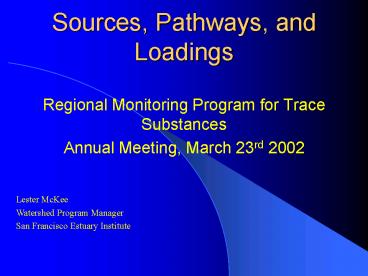Sources, Pathways, and Loadings - PowerPoint PPT Presentation
1 / 18
Title:
Sources, Pathways, and Loadings
Description:
Flux = mean daily SSC x daily Delta Outflow ... The SSC data collected by the USGS are suitable for loads analysis and if these ... – PowerPoint PPT presentation
Number of Views:24
Avg rating:3.0/5.0
Title: Sources, Pathways, and Loadings
1
Sources, Pathways, and Loadings
- Regional Monitoring Program for Trace Substances
- Annual Meeting, March 23rd 2002
Lester McKee Watershed Program Manager San
Francisco Estuary Institute
2
SPL Objectives and Structure
Objective To describe general sources and
loadings of contaminants to the Bay
3
Work Group Members
4
History of Completed Work Products
- 1999
- Technical report of the SPLWG (Davis, Abu-Saba,
Gunther) - 2000
- Contaminant Loads from Stormwater to Coastal
Waters in the San Francisco Bay Region (Davis,
McKee, Leatherbarrow, Daum) - 2001
- Estuary Interface Pilot study (Leatherbarrow,
Hoenicke, McKee) - Air Deposition Pilot Studies (Hg, TM, PAHs and
PCBs) (Tsai, Hoenicke) - Literature Review of Loading of Sediment
Particles to the Bay from the Central Valley
(McKee, Ganju, Schoellhamer, Davis, Yee,
Leatherbarrow, Hoenicke) - Projects near completion
- Storm drain mapping pilot study
- Urban runoff processes literature review and
local data synthesis
5
Literature Review of Loading of Sediment
Particles to the Bay from the Central Valley
- Lester McKee, SFEI
- Neil Ganju and David Schoellhamer, USGS
- Jay Davis, Don Yee, Jon Leatherbarrow, SFEI
- Rainer Hoenicke, State Resources Agency
6
Why are Particle Loads Important?Objectives of
the Literature Review
- Most contaminant that are currently of concern in
the Bay attach to particles - The Central Valley the largest pathway of
particles and therefore contaminants to the Bay - The objective during 2001 was to determine if the
data collected by USGS is suitable for
determining particle loads to the Bay - To propose a study for 2002 on sediment
associated contaminants to fill data gaps
7
Sampling Methods
- USGS has maintained an OBS instrument at Mallard
Island since 1994 - USGS collects water samples for SSC analysis
- Regression and estimation of SSC
- Funded by CALFED through to 2004
8
Sampling Location
9
SSC Data for the Water Years 1995-98
- Data 1995 to 1998 water years
- A full day record has 96 data points (samples
every 15 min) - 52 of the days gained a full record
- 72 of the days had gt24 out of 96 data points
- 27 of the days had no data at all due to
equipment malfunction
10
Methodology for Estimating Loads
- Fresh Water Advective
- Flux mean daily SSC x daily Delta Outflow
- On days without SSC data, load was estimated
using linear interpolation - Tidal advective
- Determined using velocity and SSC data collected
in the 1994 and 1996 WY by USGS - Errors
- A number of sources of error were considered. The
sum of the errors was ?16.5
11
Results - Advective Flux
12
Results - Dispersive Fluxes
13
Between-year Variations in Sediment Loads
14
Trends
- This mass is less than estimates from previous
studies - (Krone, 79 Smith, 63 Schultz, 65 USACE 67
Porterfield 80 Ogden Beeman 92)
Oltmann et al. (1999)
15
Implications and Conclusions
- A decreasing trend of sediment loads supports the
work of Jaffe et al. on erosion over the past 50
years in the northern bays - Local tributary loads may be becoming more
important - Contaminants stored in sediment sinks of the Bay
may become more important - There may be less sediment available for
restoration projects - The SSC data collected by the USGS are suitable
for loads analysis and if these are combined with
contaminant data, estimates of contaminant loads
can be made
16
2002 RMP Special StudyEstimating
Particle-associated Contaminant Loads from the
Sacramento and San Joaquin Watersheds
- Objectives
- To determine loads of Hg, TM, PCB, PAHs, and
historic use pesticides (OCs) entering the Bay
from the Central Valley - Method
- Flood response water column sampling
- Relationships between contaminants and suspended
sediment - Progress
- Jan 2002 UCSC/ SFEI team begins sampling
- Jan/ Feb 2002 Peer-review comments used to
refine the study design
17
2002 SPL Activities
- Review the roles and structure of the SPLWG
- Improve linkages with WQAS, SWAMP, USGS watershed
sediment loads monitoring - Invite and pay specific scientific experts to
contribute to the new field study based SPL - Gain funding and begin work on new special
studies
18
"It has often been observed, that those who have
the most time at their disposal profit by it the
least. A single hour a day, steadily given to the
study of some interesting subject, brings
unexpected accumulations of knowledge." (William
Ellery Channing)
- "In times of change learners inherit the earth
while the learned find themselves beautifully
equipped to deal with a world that no longer
exists." (Eric Hoffer)































